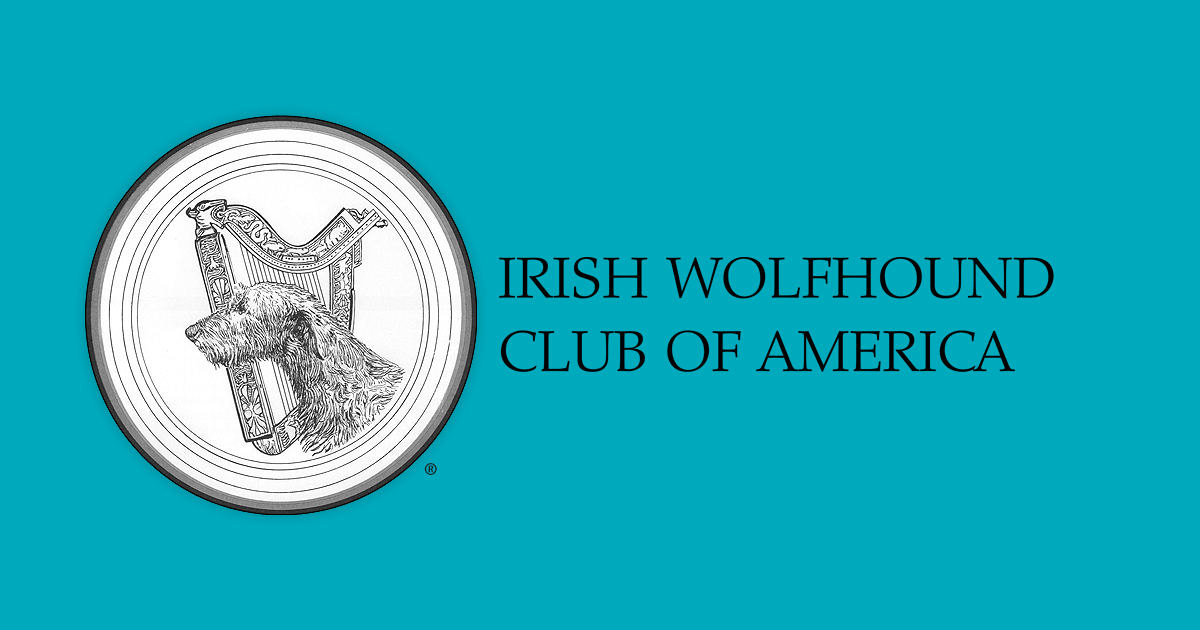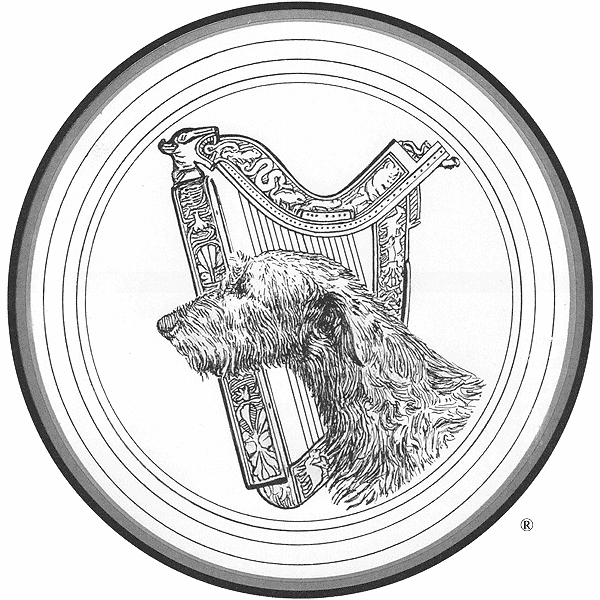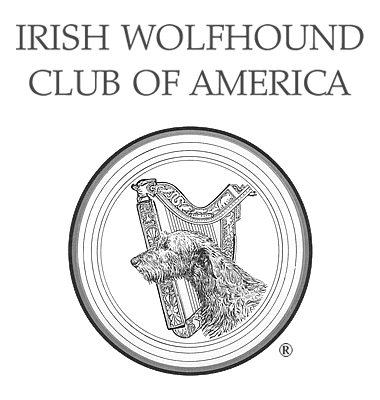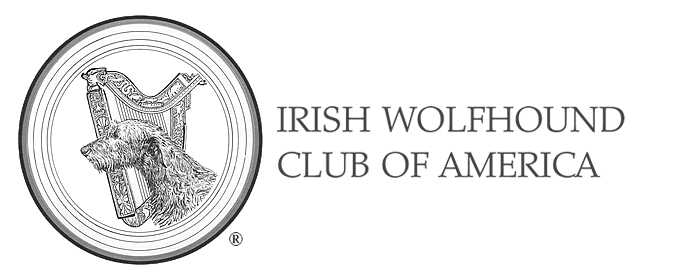Wolfhound FAQs
Below are the answers to our most frequently asked questions. For more information, please download the IWCA's brochure about the Irish Wolfhound.
As noted in the breed standard, males should be at least 32 inches tall at the shoulder and at least 120 pounds; bitches should be at least 30 inches and 105 pounds. These minimum height and weights apply only to adult hounds over 18 months of age. Males usually "average" around 34-35 inches and 140-180 pounds, bitches around 32-34 inches and 115-140 lbs.
Bigger is not necessarily better! There is a lot more to the breed than "XX inches" or "XXX" pounds.
A tall hound might be tall due only to incorrect straight bone structure and may well develop corresponding problems later on - arthritic changes due to excessive wear and tear on the joints, for instance.
In the same vein, do not encourage your hound to stand on his/her hind legs - this especially applies to young puppies. Aside from behavior problems later on (no one wants to be jumped on by a 100-plus pound dog), it can also cause stress on bones and muscles and possible injury.
Puppies can eat quite a lot while growing up, in several daily meals. Some are picky eaters, others are chow hounds. It is important not to overfeed, which might cause loose bowels and stomach upsets. Follow the diet recommended by your breeder (this assumes you will purchase a puppy from a responsible breeder, who will know proper diet and feeding methods).
Adult hounds usually are fed two meals a day.
The average lifespan of an Irish Wolfhound is 6-8 years.
For the average purchase price of an IW puppy, check with a contact person(s) in your area. Be wary of prices far above or far below the average.
On average, the IW is a fairly expensive dog to properly maintain. Any medications required (including heartworm preventative) will be two to three times as much in quantity as for the average dog, and the diet should be a quality one (what you think you would save buying cheap kibble you'll pay over and over again with an unhealthy hound and vet bills). And of course there will be the bigger vehicle, the oversized sofa ...
IWs have a dual coat - a harsh wiry outercoat and a softer undercoat. They shed year-round, but do not "blow coat" as do longer-coated breeds. Weekly or bi-weekly brushing and combing will keep the coat in good shape.
Note: If your veterinarian hasn't much sighthound or IW experience, most experienced IW veterinarians are happy to share their knowledge. Ask your breeder and/or the local club for a reference to such a veterinarian. Experienced IW people are also a valuable resource for breed-related health information.
While the internet can be a good source of information, it can also provide a great deal of misinformation - whether outdated, anecdotal, hysterical, misinterpreted, or just plain wrong. Always discuss medical concerns with your veterinarian and your breeder.
Please visit our Health pages for detailed information.
Irish Wolfhounds need a secure, above-ground fence. They are sighthounds, fast and strong, and accounts involving dogs going through invisible fences with tragic results are heard all too often. A sighthound looks across the horizon to see its boundaries: they should see their fence.
In addition, an invisible fence will not keep other animals or people out of your yard and can result in your dog being attacked or stolen.
An Irish Wolfhound should never be tied or staked out, ever. They are a large, agile hound and tie-out methods are completely unsuitable, giving them only the most restricted of exercise, and can cause injury as well.
Irish Wolfhounds want to be with their people. Some breeders with multiple hounds may have a kennel establishment, of course (and probably spend more time there than in their own home); but in speaking of one or two (but sometimes even more!) hounds, inside with you is where they should be.
IWs love to romp freely, especially when puppies. They should have a secure, above-ground fenced area for this activity. Puppies should not be subjected to forced exercise, even long walks, until at least a year or more of age.
Adults can become couch potatoes, especially if you are one yourself - they adapt quite well to your schedule! They love long walks with their people; don't let them become soft and prone to injury/illness.
Some puppies can be very destructive, some aren't. All puppies need to be watched; if a puppy must be left alone, it should be provided with a safe place to stay (perhaps a crate) and safe toys to chew.
IW puppies housebreak rather quickly; a crate can be helpful, especially overnight. However, while crating can be a useful housebreaking tool, they should never be crated routinely for long periods of time (such as during work hours), which can be detrimental to muscles and joints, and encourage formation of bursas. Long hours of crating or kenneling with little opportunity for socialization can foster timidity in a hound and leave their personalities undeveloped.
IWs are fast learners. They respond best to positive training methods.
Basic obedience and socialization are very important for a growing puppy.
There is no such thing. "Rare" implies some sort of value placed on a particular color, but no color in the IW is valued above another (except possibly to a seller trying to provoke a sale at inflated prices to the uninformed). Some colors appear less frequently than others, is all.
Dogs - In general, IWs get along fine with other dogs, but should not be raised with aggressive breeds.
Cats, rabbits, etc. - This is a sighthound, bred for centuries to chase, hunt and bring down game, so do not assume small animals won't be chased (which could result in the smaller animal being injured or even killed). Some IWs are fine with cats, especially if raised with them; others are not. It is wise to evaluate each IW on an individual basis.
Horses - Hounds should be taught when small pups to respect the horse. Do not assume the hound will not chase the horse, which can result in grave injury to the hound.
IWs are good with children, but of course, use common sense - even a puppy is large enough to knock down a small child in play. Children and dogs should always be monitored when together.
IWs are not horses - back injuries could result even with a seemingly light weight.
IWs are also not draft dogs; they are not structured for weight-pulling. Just because they can do it, doesn't mean they should.
No. In itself, their size can be a deterrent, but by nature, they are companion dogs and do not have the "guard dog" temperament. Aggression in any form should never be encouraged.



